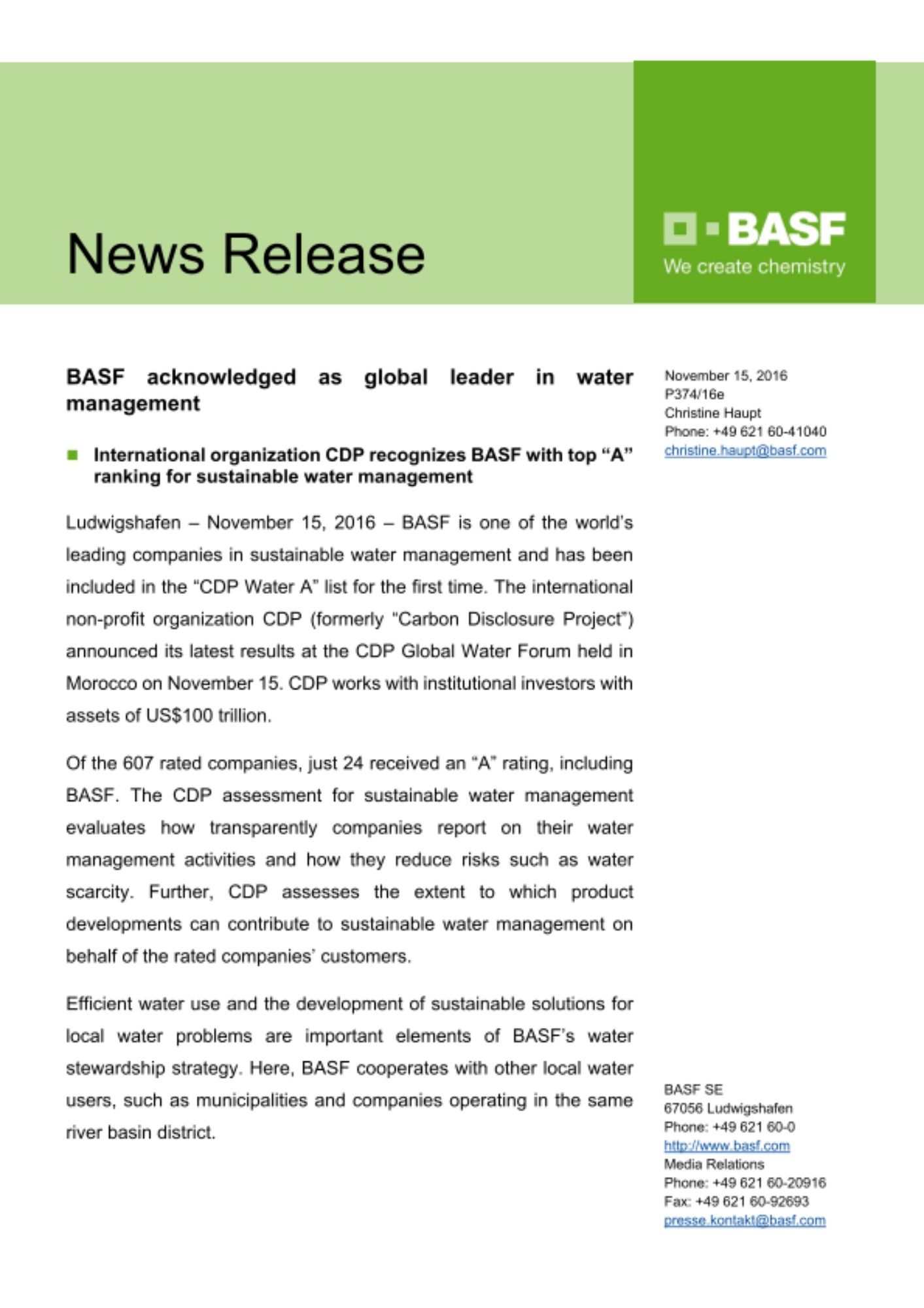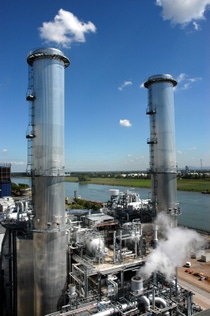Media
BASF acknowledged as global leader in water management
- International organization CDP recognizes BASF with top “A” ranking for sustainable water management
Ludwigshafen – November 15, 2016 – BASF is one of the world’s leading companies in sustainable water management and has been included in the “CDP Water A” list for the first time. The international non-profit organization CDP (formerly “Carbon Disclosure Project”) announced its latest results at the CDP Global Water Forum held in Morocco on November 15. CDP works with institutional investors with assets of US$100 trillion.
Of the 607 rated companies, just 24 received an “A” rating, including BASF. The CDP assessment for sustainable water management evaluates how transparently companies report on their water management activities and how they reduce risks such as water scarcity. Further, CDP assesses the extent to which product developments can contribute to sustainable water management on behalf of the rated companies’ customers.
Efficient water use and the development of sustainable solutions for local water problems are important elements of BASF’s water stewardship strategy. Here, BASF cooperates with other local water users, such as municipalities and companies operating in the same river basin district.
More about water management of BASF: https://www.basf.com/en/company/sustainability/environment/water.html
More about sustainability ratings and rankings of BASF: https://www.basf.com/en/company/investor-relations/sustainable-investments/sustainability-ratings-and-rankings.html
About BASF
At BASF, we create chemistry for a sustainable future. We combine economic success with environmental protection and social responsibility. The approximately 112,000 employees in the BASF Group work on contributing to the success of our customers in nearly all sectors and almost every country in the world. Our portfolio is organized into five segments: Chemicals, Performance Products, Functional Materials & Solutions, Agricultural Solutions and Oil & Gas. BASF generated sales of more than €70 billion in 2015. BASF shares are traded on the stock exchanges in Frankfurt (BAS), London (BFA) and Zurich (BAS). Further information at www.basf.com.
P-16-374

![Eine Fläche von rund 64.000 Quadratmetern - das entspricht 13 Fußballfeldern - umfasst der Steamcracker II, die größte einzelne Anlage am Standort Ludwigshafen der BASF. Der Cracker ist auch das „Herzstück" der Verbundproduktion. Seit 1981 ist dieser Gigant in Betrieb und spaltet unter Zusatz von Wasserdampf bei etwa 850 Grad Celsius Rohbenzin auf. Dabei entstehen im wesentlichen Ethylen und Propylen, beides unverzichtbare Grundstoffe für die Herstellung vieler Produkte in Ludwigshafen.
Abdruck honorarfrei. Copyright by BASF.
Steam cracker II, the largest individual plant at BASF's Ludwigshafen site, covers a surface area of about 64,000 square meters, which is about the size of 13 soccer fields. The steam cracker is also the heart of BASF's Verbund production strategy. This giant plant has been operating since 1981 and uses steam to crack naphtha at about 850°C [1,562°F]. This process leads primarily to ethylene and propylene, both indispensable feedstocks for manufacturing numerous products in Ludwigshafen.
Print free of charge. Copyright by BASF. Eine Fläche von rund 64.000 Quadratmetern - das entspricht 13 Fußballfeldern - umfasst der Steamcracker II, die größte einzelne Anlage am Standort Ludwigshafen der BASF. Der Cracker ist auch das „Herzstück" der Verbundproduktion. Seit 1981 ist dieser Gigant in Betrieb und spaltet unter Zusatz von Wasserdampf bei etwa 850 Grad Celsius Rohbenzin auf. Dabei entstehen im wesentlichen Ethylen und Propylen, beides unverzichtbare Grundstoffe für die Herstellung vieler Produkte in Ludwigshafen.
Abdruck honorarfrei. Copyright by BASF.
Steam cracker II, the largest individual plant at BASF's Ludwigshafen site, covers a surface area of about 64,000 square meters, which is about the size of 13 soccer fields. The steam cracker is also the heart of BASF's Verbund production strategy. This giant plant has been operating since 1981 and uses steam to crack naphtha at about 850°C [1,562°F]. This process leads primarily to ethylene and propylene, both indispensable feedstocks for manufacturing numerous products in Ludwigshafen.
Print free of charge. Copyright by BASF.](/api/imaging/focalarea/original/210x/dam/jcr%3Afd31f0bb-2243-3aef-9cbd-0280aaf0453b/1_Verbundstandort_Ludwigshafen_Steamcracker.jpg)
